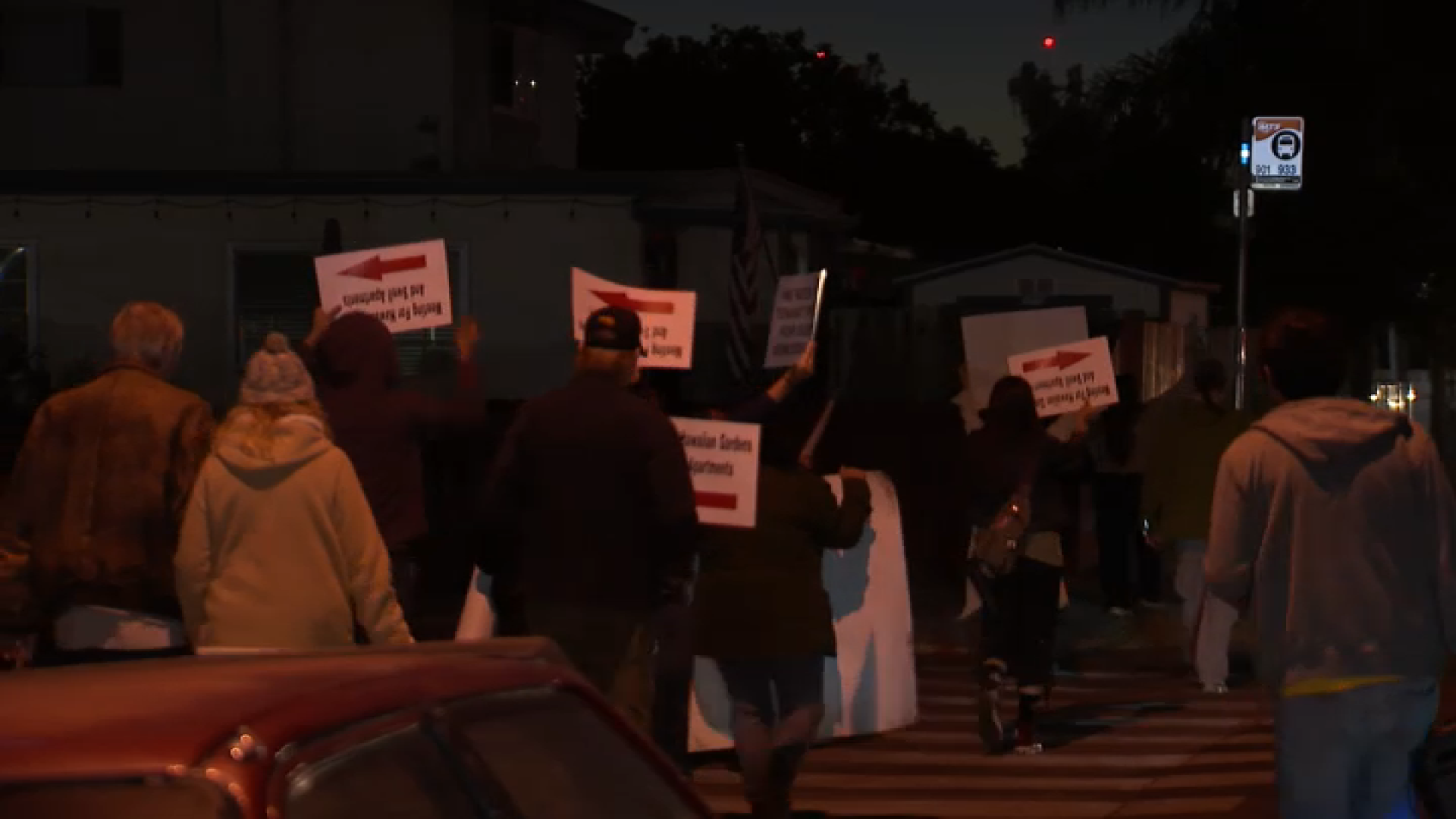
Charges relating to the alleged arson of the USS Bonhomme Richard brought forth against Seaman Recruit Ryan Sawyer Mays have been referred to court-martial, a representative for the U.S. 3rd Fleet confirmed Friday morning.
"After careful review of the preliminary hearing report, Vice Adm. Steve Koehler, commander, U.S. 3rd Fleet, referred charges against Seaman Recruit Ryan Sawyer Mays to general court-martial," a statement read, adding, "Charges were brought in response to evidence found during the criminal investigation into the fire that started on the former USS Bonhomme Richard on July 12, 2020."
Mays faces two charges, willful hazarding of a vessel and aggravated arson, both alleged violations of the Uniform Code of Military Justice.
Get top local stories in San Diego delivered to you every morning. Sign up for NBC San Diego's News Headlines newsletter.
A date has not been announced for the general court-martial, but Mays' defense attorney Gary Barthel said it will likely begin in early March.
"Seaman Mays is disheartened that the same Navy Leadership that appointed Capt Tang to preside over the preliminary hearing, has decided to disregard her recommendation that the case NOT proceed to trial and instead has made the decision to move forward with a trial in his case," Barthel wrote in a statement shared with NBC 7.
"For Navy Leadership to disregard Capt Tang’s recommendation and to decide to refer the case to trial makes it abundantly clear that the Navy’s motive is not to seek justice in this case, but rather to seek to make Seaman Mays a scapegoat for a fire that started and was allowed to burn for days due to the verified negligence of Navy personnel in leadership positions who could have prevented the destruction of the USS Bonhomme Richard. Although disappointed by the Commander Third Fleet’s decision to move forward with a trial by court-martial in this case, Seaman Mays continues to maintain his innocence and looks forward to the opportunity to prove he is, in fact, innocent of the allegations made against him," the statement added.
Local
When asked about the allegations, Cmdr. Sean Robertson, Third Fleet Public Affairs Officer, wrote "Vice Adm. Koehler made his decision after considering the entirety of the preliminary hearing officer’s report.”
In addition to the charges being announced early Friday, it was shared that Mays had also been demoted on January 11, 2022 from the rank of Seaman Apprentice, which he held at the time of the fire onboard the USS Bonhomme Richard, to the rank of Seaman Recruit.
A Navy spokesperson was unable to confirm what led to the demotion of Mays' rank.
Article 32 Hearing
Navy prosecutors alleged during the first day of Mays' Article 32 hearing that he was charged with setting the fire that destroyed the USS Bonhomme Richard last year and was “disgruntled” after dropping out of Navy SEAL training. His defense lawyers, however, said there was no physical evidence connecting him to the blaze.
One sailor, Edwin Kongo, testified that he thanked Mays for saving his life after he alerted him there was a fire on board. Kongo said he had woken up minutes before Mays told him to get off the ship.
A key witness for the Navy testified that he is certain he saw Mays in the area where the flames ignited, and another sailor said the suspect mumbled “I’m guilty” on the way to the brig after being taken into custody.
Additional testimony from Carissa Tubman, a sailor who was assigned to escorting Mays to the brig on Aug. 20, 2020, testified that she heard a stunned Mays mumble to himself: “I’m guilty, I guess. I did it.” Then she said he mumbled some more before she heard him say: “It had to be done.”
Defense attorneys said he was joking and speaking sarcastically after being surprised that he was being locked up.
Andrew Thoresen, a forensic electrical engineer hired by Mays' defense attorneys, testified during the final day of the hearing that the fire might have started with a faulty cable, while a former federal fire investigator said he also found no data to back the government's finding that it was arson.
Thoresen testified that he found highly combustible lithium ion batteries with their caps blown off and a copper cable with a melted end in the engine of a forklift, indicating it may have sparked the fire.
“They cannot be eliminated” as a source of the fire, said Thoresen, who has examined 3,000 fire scenes as a forensic electrical engineer.
Phil Fouts, a former federal fire investigator also hired by defense attorneys, told the court he agreed after inspecting the ship.
“For me, the cause of the fire is undetermined at this point," said Fouts, a former fire investigator with the Bureau of Alcohol, Tobacco, Firearms and Explosives, adding later: “I have not eliminated the forklift and batteries [as potential causes], and I don't have any data to support an intentionally set fire."
Both the batteries and forklift were inside the lower vehicle storage area of the warship, where the lead federal fire investigator for the government determined the July 12, 2020, fire was started by someone who ignited carboard boxes stored there.
Much of the case relies on sailors’ accounts of that morning.
Defense Attorney Gary Barthel pointed out no DNA linked to Mays was found at the scene, and he questioned why investigators concluded Mays did it just because they found a lighter among his belongings.
The Warrant
The Navy preferred charges against Mays on July 29, 2021, more than a year after the fire on the amphibious assault ship Bonhomme Richard began as it was going through a "maintenance availability" at Naval Base San Diego in July 2020.
Mays was publicly identified after a Naval Criminal Investigative Services (NCIS) search warrant was unsealed in August 2021 by investigators. The NCIS documents also included a picture of the sailor taken from one of his social media accounts.

Mays enlisted in the Navy in 2019 and later tried out for Basic Underwater Demolition/SEAL (BUDS) training, according to the warrant. Five days in, Mays exercised his option to drop out of the grueling, high-intensity training course and was assigned to USS Bonhomme Richard as an undesignated seaman.
The fire was classified as arson within days of NCIS and ATF investigators setting foot on the ship. NCIS records filed in federal court suggest someone aboard USS Bonhomme Richard tampered with crime scene evidence in the days that followed.
On July 20, 2020, ATF investigators found an uncapped plastic bottle with trace amounts of liquid in it near the fire's origin. Investigators marked the bottle with tape to alert crime scene technicians, but when investigators returned the next day the bottle was gone and the marking tape had been discarded on the floor. During the time the bottle went missing, Mays' duty section had access to the area, according to the warrant.
Investigators also found three more bottles, some with holes poked in the middle of their caps, and aluminum cans with liquid inside. Tests on at least one of the bottles or cans confirmed the liquid was heavy petroleum distillate, or highly flammable fuel.
During a walk-through of the fire origin area on July 22, 2020, a lieutenant commander responsible for the ship's firefighting equipment noticed three of four firefighting stations in the area were misconfigured. In one station, there were no connected fire hoses. Another fire station was described by the lieutenant commander as inoperable.
There was also a hose at another station that was cut, which firefighters discovered during firefighting efforts, according to the warrant.
A little more than a month after the fire, NCIS investigators spent 10 hours interviewing Mays. The interview included a walk-through of USS Bonhomme Richard, according to the warrant.
Mays was arrested following the interview. During the booking process, two sailors reported hearing Mays say, out loud, that he was guilty of starting the fire on July 12, 2020. NCIS was alerted and Mays was brought back in for more questioning. Mays told investigators he was not guilty and denied having said so, the warrant said.
The Blaze and Navy's Investigation
The fire aboard USS Bonhomme Richard broke out July 12, 2020, and burned for nearly five days. It started in the ship's lower storage area, where cardboard boxes, rags and other maintenance supplies were stored. Strong winds coming off the San Diego Bay and at least two explosions — one heard as far as 13 miles away — helped it sprawl out of control.
About 160 sailors were aboard the ship at the time the fire was sparked and the were able to disembark. At least 57 people — 34 sailors and 23 civilians — were hospitalized with minor injuries, Naval Surface Forces said last year.
After the fire, the amphibious assault ship was left with extensive structural, electrical and mechanical damage and was later scrapped, costing the Navy billions of dollars.
The U.S. Navy decommissioned the USS Bonhomme Richard on April 14, 2021, nine months after flames engulfed it in one of the worst U.S. warship fires outside of combat in recent memory.
The Navy estimated that repairing the ship would run more than $2.5 billion. Dismantling the ship is expected to cost about $30 million.
A Navy report published in October of last year, concluded there were sweeping failures by commanders, crew members and others that fueled the July 2020 arson fire that destroyed the USS Bonhomme Richard, calling the massive five-day blaze preventable and unacceptable.
The more than 400-page report, obtained by The Associated Press, lists three dozen officers and sailors whose failings either directly led to the ship's loss or contributed to it. The findings detailed widespread lapses in training, coordination, communication, fire preparedness, equipment maintenance and overall command and control.
“Although the fire was started by an act of arson, the ship was lost due to an inability to extinguish the fire,” the report said, concluding that “repeated failures” by an “inadequately prepared crew” delivered "an ineffective fire response."
It slammed commanders of the amphibious assault ship for poor oversight, and said the main firefighting foam system wasn't used because it hadn't been maintained properly and the crew didn't know how to use it.
U.S. Navy officials said that while crews at sea consistently meet high firefighting standards, those skills drop off when ships move into maintenance periods. The Bonhomme Richard was undergoing maintenance at the time of the fire.
The report spreads blame across a wide range of ranks and responsibilities, from the now retired three-star admiral who headed Naval Surface Force Pacific Fleet — Vice Adm. Richard Brown — to senior commanders, lower ranking sailors and civilian program managers. Seventeen were cited for failures that “directly” led to the loss of the ship, while 17 others “contributed” to the loss of the ship. Two other sailors were faulted for not effectively helping the fire response. Of the 36, nine are civilians.
The report, written by Vice Adm. Scott Conn, included a number of recommended changes and improvements that have been endorsed by Lescher. The Navy set up a new fire safety assessment program that conducts random inspections, and has taken steps to increase training. Nearly 170 of those inspections have already been done, and officials said they are finding good results.
The Navy also conducted a historical study, looking closely at 15 shipyard fires over the past 12 years. It found recurring trends including failures to comply with fire prevention, detection and response policies.
As a result, Navy leaders are expanding the staffing and responsibilities of the Naval Safety Center, to perform audits and unannounced assessments of Navy units. The final costs are still being calculated.
The Associated Press contributed to this report -- Ed.



